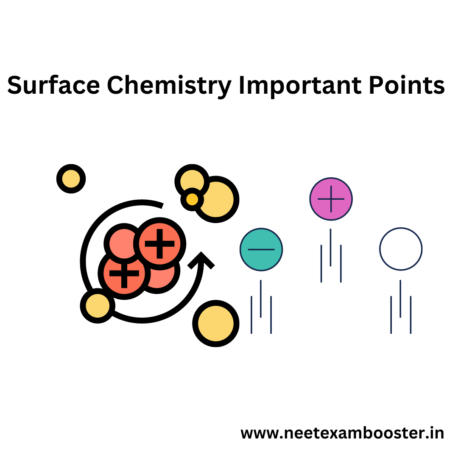Surface Chemistry Important Points – Surface chemistry is a branch of chemistry that focuses on the phenomena occurring at the interfaces between different phases, such as solid-gas, solid-liquid, and liquid-gas interfaces. It involves the study of adsorption, which can be physical or chemical in nature. Physical adsorption is a weak, reversible process based on van der Waals forces, while chemical adsorption involves the formation of chemical bonds.
Catalysts are substances that accelerate chemical reactions by providing an alternative pathway with lower activation energy. Heterogeneous catalysts operate in a different phase from the reactants, and their effectiveness depends on the availability of active sites on their surface. Catalytic activity is related to the number of active sites, while catalysts can be deactivated by poisons. Colloids are intermediate-sized particles dispersed in a continuous medium, like a liquid or a gas. They can be classified into different types, such as sols, gels, emulsions, and aerosols. Colloidal systems exhibit properties like the Tyndall effect and can be stabilized or destabilized by adding electrolytes or adjusting the pH.
Surface chemistry finds applications in various industries, particularly in catalysis, where it plays a vital role in enhancing reaction rates and improving efficiency. It also has implications in areas like materials science, environmental remediation, and pharmaceuticals.
Surface Chemistry Important Points, Surface Chemistry Important Points, Surface Chemistry Important Points, Surface Chemistry Important Points, Surface Chemistry Important Points, Surface Chemistry Important Points, Surface Chemistry Important Points

NCERT Chemistry Class 12 Chapter 5 – 25 Surface Chemistry Important Points
There are 25 important points on Surface chemistry –
- Surface chemistry deals with the study of phenomena that occur at the interface of two phases, such as solid-gas, solid-liquid, and liquid-gas interfaces.
- Adsorption is an important phenomenon in surface chemistry, where molecules or ions from a gas or liquid phase are attracted and accumulate on the surface of a solid.
- There are two types of adsorption: physical adsorption (physisorption) and chemical adsorption (chemisorption).
- Physical adsorption is a weak, reversible process that involves weak van der Waals forces between the adsorbate and the adsorbent surface.
5. Chemical adsorption is a stronger, irreversible process that involves the formation of chemical bonds between the adsorbate and the adsorbent surface.
- The extent of adsorption is influenced by factors such as temperature, pressure, nature of the adsorbate and adsorbent, and surface area of the adsorbent.
- The adsorption isotherm describes the relationship between the amount of adsorbate adsorbed and the equilibrium pressure or concentration of the adsorbate.
- The Freundlich adsorption isotherm is often used to describe physical adsorption, while the Langmuir adsorption isotherm is used for chemisorption.
- Catalysts are substances that increase the rate of a chemical reaction by providing an alternative reaction pathway with lower activation energy.
- Heterogeneous catalysts operate in a different phase than the reactants, and their effectiveness depends on the availability of active sites on their surface.
- The concept of catalytic activity is related to the number of active sites available on the catalyst surface.
- Catalytic poisons are substances that deactivate catalysts by blocking or occupying the active sites.
- Colloids are intermediate-sized particles (between 1 and 1000 nanometers) dispersed in a continuous medium, such as a liquid or a gas.
- The Tyndall effect is the scattering of light by colloidal particles, which makes the particles visible under a beam of light.
- Colloids can be classified based on the nature of the dispersed phase and the dispersion medium into various types, such as sols, gels, emulsions, and aerosols.
16.Micelles are aggregates of surfactant molecules in a colloidal system, where the hydrophilic “head” groups are oriented towards the aqueous phase and the hydrophobic “tail” groups are oriented towards the interior.
- The properties of colloidal solutions, such as stability, coagulation, and precipitation, can be controlled by the addition of electrolytes or by changing the pH of the system.
- The electrical properties of colloidal particles play a crucial role in their stability and behavior. Charged particles tend to repel each other, preventing coagulation.
- The electrophoresis phenomenon involves the migration of charged colloidal particles under the influence of an electric field.
- Coagulation or flocculation refers to the destabilization and aggregation of colloidal particles, leading to the formation of larger particles that settle down.
- Adsorption plays a significant role in the coagulation process by neutralizing the charges on the particles and allowing them to come closer.
- Catalysts in colloidal form, known as catalytic colloids, exhibit high catalytic activity due to their large surface area and the presence of active sites.
- Catalysts used in industries, such as platinum and palladium, are often supported on finely divided solid materials to increase their surface area.
- Surface chemistry finds applications in various industries, particularly in catalysis, where it plays a vital role in enhancing reaction rates and improving efficiency.
- It also has implications in areas like materials science, environmental remediation, and pharmaceuticals.
Some Important Questions From Biology Class 11
| Chapter Name | Quiz Link |
| The Living World | Play Now |
| Biological Classification | Play Now |
| Plant Kingdom | Play Now |
| Animal Kingdom | Play Now |
| Morphology of flowering plants | Play Now |
| Anatomy of flowering plants | Play Now |
| Cell: the unit of life | Play Now |
| Biomolecules | Play Now |
| Cell Cycle and cell division | Play Now |
| Transport in Plants | Play Now |
| Structural organisation in Animals | Play Now |
| Mineral nutrition | Play Now |
| Photosynthesis in higher plants | Play Now |
| Respiration in plants | Play Now |
| Plant Growth and development | Play Now |
| Digestion and Absorption | Play Now |
| Breathing and Exchange of Gases | Play Now |
| Body fluids and circulation | Play Now |
| Excretory products and their elimination | Play Now |
| Locomotion and Movement | Play Now |
| Neural Control and Coordination | Play Now |
| Chemical Coordination and Integration | Play Now |
Some Important Questions From Biology Class 12
| Chapter Name | Quiz Link |
| Reproduction in organism | Play Now |
| Sexual reproduction in flowering plant | Play Now |
| Human reproduction | Play Now |
| Reproductive health | Play Now |
| Principles of inheritance and variation | Play Now |
| Molecular basis of inheritance | Play Now |
| Evolution | Play Now |
| Human health and disease | Play Now |
| Strategies for enhancement in food product | Play Now |
| Microbes in human welfare | Play Now |
| Biotechnology principles and processes | Play Now |
| Biotechnology and its application | Play Now |
| Organism and population | Play Now |
| Ecosystem | Play Now |
| Biodiversity and its conservation | Play Now |
| Environment issue | Play Now |





 155 out of 200 questions were directly asked from these notes in NEET 2024
155 out of 200 questions were directly asked from these notes in NEET 2024
